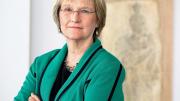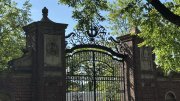In January 1916, more than 1,100 Harvard students, many motivated by the possibility of the United States’ entrance into the Great War, joined what would become one of the country’s first Reserve Officers’ Training Corps (ROTC) programs. In addition to their usual course of study, young men in the Harvard Regiment received theoretical and practical military instruction, drilled and marched at Soldiers Field, completed complex exercises in nearby towns, and—on at least one occasion—paraded through Boston in a show of national “preparedness.” Their commander, Captain Constant Cordier, considered them inspired by “an invincible spirit” and remarked that “in all this land there is no better material for officers than is found in the student body of Harvard.”
One century later, we mark the return to our campus of the full complement of ROTC: Air Force, Army, and Navy. I have had the honor of restoring the full and formal recognition of these programs in the five years since the repeal of “don’t ask, don’t tell,” and I have admired those undergraduates who choose to serve the nation, whether they are completing deployments in Afghanistan, training pilots aboard aircraft carriers halfway around the world, or inspiring their fellow citizens with a flyover at the Harvard-Yale game. These young people join an extraordinarily distinguished group of alumni: the University has educated more Medal of Honor recipients than any college or university other than the service academies, and our graduates have been decorated with the highest honors from each of the service branches.
Our campus community includes hundreds of men and women who have already served or who will return to service after they complete their studies. At the Business School, the Kennedy School, and the Law School, among others, student veterans and service members bring to their learning and their practice rare perspectives and, in sharing their expertise and thinking, give their classmates insight into an institution that is so important to our nation. They extend their influence beyond our campus through volunteer opportunities including the Center for Public Leadership’s “Veterans Impact Day,” which recently put more than 150 students from Harvard and local colleges in direct contact with those who have served. In the coming year, the Yellow Ribbon Program, which assists veterans with tuition and fees, will, for the first time, be open to an unlimited number of eligible students across our Schools.
Harvard’s soldier-scholars undertake their diverse work in a place where one is everywhere reminded of distinguished military service and sacrifice. My days and nights in Cambridge are spent in Massachusetts Hall and Elmwood, both of which were used to house troops during the American Revolution; nearby Wadsworth House sheltered George Washington when he came to take command of the Continental Army. Other quiet corners are dedicated to those who served later and farther afield. Plaques and walls listing the names of those who gave their last full measure of devotion are familiar sights at the Divinity School, the Law School, the Medical School, and elsewhere, and Memorial Church and Memorial Hall have become landmarks, guiding our way as they stand testament to the human cost of supporting and defending the Constitution.
When I was preparing my remarks to the first class of students commissioned after Harvard renewed its military ties, I found inspiration in a name etched into the walls of the Memorial Hall transept. Charles Russell Lowell, valedictorian of the College Class of 1854, served in the Union Army and died shortly after being wounded at the Battle of Cedar Creek—not far from where I grew up in Virginia’s Shenandoah Valley. A decade before he made the ultimate sacrifice for his country, he addressed his classmates, urging them both to consider what should be and to imagine what can be. This uneasiness with the present married with an eagerness to shape the future is among the finest traditions shared by Harvard University and the United States Armed Forces, and we are privileged to renew fully in this centennial year a longstanding and vigorous partnership. “The world,” as Lowell would remind us, “always advances by impossibilities achieved.”









